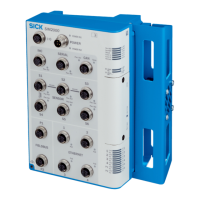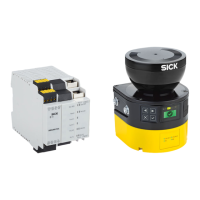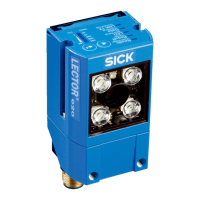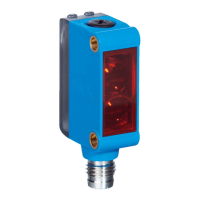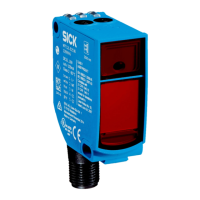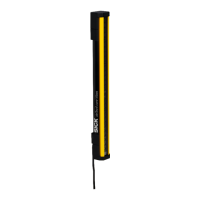For protective fields extending >100cm, any multiple sampling setting can be
se
lected. For protective fields extending <100cm, the multiple sampling setting must
be no greater than 3. Otherwise a person could walk undetected through the protective
field.
4.3.12.2 Calculation example for the minimum distance
Overview
T
he following examples show the calculation of the minimum distance S for an
approach orthogonal or parallel to the optical axis (Z-axis) of the camera sensor. The
calculation is performed in accordance with ISO 13855 and the specific specifications
of the camera sensor. A different calculation may be required depending on the appli‐
cation and the ambient conditions, for example when approaching the optical axis of
the camera sensor at any angle.
Minimum distance S with orthogonal approach to the optical axis
S = 1,600mm/s × T + C
W
here:
•
S =minimum distance, in millimeters (mm)
•
T = stopping/run-down time for the entire system, in seconds (s)
(Response time of the device + machine’s stopping/run-down time, including
r
esponse time of the machine’s control system and signal propagation time)
•
C = supplement in millime
ters (mm)
The reach/approach speed is already included in the formula.
Table 12: Supplement C with orthogonal approach to the optical axis, access protection
Object resolution
H
and
Object resolution
Arm
Object resolution
Leg
Object resolution
Body
Object resolution is
no
t applicable to this
application.
Object resolution is
not applicable to this
application.
70mm 170mm
Minimum distance S with parallel approach to the optical axis
S = 1,600mm/s × T + Tz + C
W
here:
•
S =minimum distance, in millimeters (mm)
•
T = stopping/run-down time for the entire system, in seconds (s)
(Response time of the device + machine’s stopping/run-down time, including
r
esponse time of the machine’s control system and signal propagation time)
•
T
Z = tolerance zone of the device
•
C = supplement in millimeters (mm)
The reach/approach speed is already included in the formula.
Table 13: Supplement C with parallel approach to the optical axis, access protection
Object resolution
H
and
Object resolution
Arm
Object resolution
Leg
Object resolution
Body
Object resolution is
no
t applicable to this
application.
Object resolution is
not applicable to this
application.
70mm 170mm
Further topics
•
T
olerance zone of the device (TZ) see table 42, page 90
•
"Approach direction", page 27
4 P
ROJECT PLANNING
34
O P E R A T I N G I N S T R U C T I O N S | safeVisionary2 8025919/1I9E/2023-01-09 | SICK
Subject to change without notice
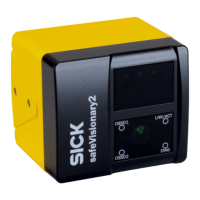
